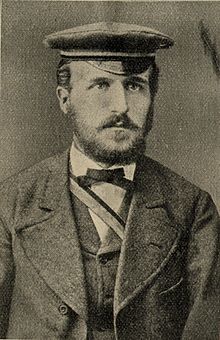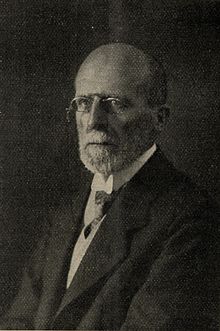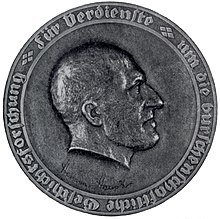Herman Haupt (historian)

Herman Haupt (born June 29, 1854 in Markt Bibart , Middle Franconia ; † September 29, 1935 in Betzdorf an der Sieg) was a German regional and church historian and librarian . He was the nestor of fraternity historical research.
Life
Haupt was the sixth child of the lawyer Christian August Haupt (1815–1862), who had participated in the Frankfurt Wachensturm in 1833 as a member of the Würzburg fraternity Germania , and his wife Gertrud geb. Reuss. Between 1832 and 1961, 15 fraternity members emerged from the Haupt family .
Haupt attended the old grammar school in Würzburg and the Gustavianum grammar school in Schweinfurt . After graduating from high school, he attended the Julius Maximilians University of Würzburg in the winter semester of 1871/72 and listened to classical philology and history . Like numerous other members of his family, he joined the Arminia fraternity and became an active member on October 18, 1871. The fraternities Franconia Gießen (1908), Germania Gießen (1920) and Saxonia Hann. Münden (1923) later awarded him honorary membership.
Main doctorate in 1875 in Würzburg Dr. phil. From November 1874 to the beginning of 1876 he was a teacher at his former Würzburg school. From May 1876 he worked at the University Library of Würzburg , first as a volunteer, from May 1878 as an assistant and from May 1884 as a secretary.
to water
At the end of 1885 he was appointed head of the Giessen University Library. In 1897 Haupt was appointed professor . Haupt played a key role in the planning and construction of the new library building for the Hessian Ludwig University . When it was inaugurated in 1904, Grand Duke Ernst Ludwig awarded it the title of Privy Councilor .
Haupt and the master bookbinder IP Sann invented the so-called "Giessener capsules" for the library catalog, which allow you to leaf through the card catalogs without having to remove individual cards. On his retirement on September 1, 1921, the University of Giessen awarded him the first honorary senator .
Student history
Haupt has been collecting student papers since he was a student. From 1885 he built up the Burschenschaftliche Archiv in the Giessen University Library , a worldwide unique collection on the history of the fraternities. The archive was moved to the Frankfurt am Main city archive in 1927 , was located in Würzburg between 1935/36 and 1954 and has been kept in the Federal Archives in Koblenz ever since .
With Heinrich von Srbik , Ludwig Aschoff and Friedrich Meinecke, Haupt institutionalized fraternity historical research, which Heinrich von Treitschke , Friedrich Paulsen , Theobald Ziegler and Theodor Mommsen had already called for in the 1890s. In Frankfurt am Main, Haupt, Georg Heer , Paul Wentzcke , Friedrich Meinecke and others founded the Burschenschaftliche Historische Kommission on April 13, 1909 (since 1930 the Society for Burschenschaftliche historical research ). It was supported by the university fraternities ( Deutsche Burschenschaft ), the TH fraternities in the Rüdesheim Association of German fraternities and the (Austrian) fraternities of the Ostmark . Main chairman until 1930, then honorary chairman until his death.
On the occasion of his 70th birthday, the Herman Haupt Foundation was established in 1924 to promote fraternity historical research. The highest award of the society for fraternity historical research , the Herman-Haupt-Medal , donated in 1929 on the occasion of his 75th birthday , is named after him.
In many ways he was the counterpart to his friend, contemporary Wilhelm Fabricius (historian) .
Historical activity
His main historical and journalistic activity comprised well over 300 titles between 1876 and 1934, including works on the history of ideas and the history of ideas as well as those on church, agricultural and social history. He is considered to be one of the founders of sect and heretic research in Germany.
Between 1892 and 1932 Haupt published regularly in the fraternity papers founded in 1887 . In addition, he wrote 29 résumés for the Allgemeine Deutsche Biographie and 40 for the Hessian biographies , the latter published on behalf of the Historical Commission for Hesse and Waldeck , which he co-founded and whose board he has been a member of in various functions since 1897.
In 1907, Haupt published the official chronicle and festival newspaper for the 300th anniversary of the University of Giessen. The festival edition of the Upper Hessian History Association, which he wrote in the same year on the occasion of the university anniversary about Karl Follen and the Blacks from Giessen, was trend-setting . As early as 1898 he had published a story based on source studies for the Arminia fraternity in Würzburg and in 1901 for the Germania fraternity in Giessen. The source-based approach in student history was first pursued with this consistency by Haupt. As a result, and in particular through the publication of the first 13 volumes of the sources and representations on the history of the fraternity and the German unity movement (1910–1932), he became the founder of scientific research on the fraternity. In addition, Haupt published five editions of the manual for the German fraternity from 1922 to 1929 , in which he wrote extensive chapters on the history of the fraternity.
“It is mainly thanks to the fact that student and fraternity historical research was steered into scientific paths at an early stage; In this way it was possible to abandon the restricted perspective and the isolated perspective of the individual connections in favor of a more comprehensive research subject. "
Works
- with Karl Esselborn and Georg Lehnert: Hessische Biographien , 3 vol., Hessischer Staatsverlag 1918–1934.
- with Paul Wentzcke: A hundred years of the German fraternity - fraternity résumés . Heidelberg 1921.
- The religious sects in Franconia before the Reformation , Würzburg 1882.
- Publications of the Archive for the German Burschenschaft , Issue 1–4, Berlin 1894–1896.
- The old Würzburg fraternity 1817–1833. A contribution to the history of the university in the reaction time , Würzburg 1898.
- with Hans Schneider: Festschrift for the 50th year. Foundation festivals of the Gießen fraternity Germania 1851 to 1901 , Mainz 1901.
- Karl Follen and the Blacks from Giessen. Contributions to the history of the political secret societies and the constitutional development of the old fraternity in the years 1815–1819 (communications of the Upper Hessian History Association, 15), Gießen 1907.
- Sources and representations on the history of the fraternity and the German unity movement , Vol. 1–13 (Vol. 7 and Vol. 13 with Paul Wentzcke), Heidelberg 1910–1932.
- Hessian Biographies , 3 vol. (Work of the Historical Commission for the Grand Duchy [the People's State] of Hesse), Darmstadt 1918–1934.
- Handbook for the German fraternity , 1st edition Frankfurt a. Main 1922, 2nd edition 1924, 3rd edition 1925, 4th edition 1927, 5th edition 1929.
estate
- University archive, Giessen
- Federal Archives, Koblenz, Bestd. DB 9, archive and library of the German Burschenschaft, (1726) 1815–1978, bequests: Herman Haupt
swell
- Haupt, Herman , in: Friedhelm Golücke : Author's lexicon for student and university history. SH-Verlag, Cologne 2004, ISBN 3-89498-130-X . Pp. 133-138.
- Harald Lönnecker : "The topic was and remained without parallel appearance in German historical research" - The Burschenschaftliche Historische Kommission (BHK) and the Gesellschaft für Burschenschaftliche Geschichtsforschung e. V. (GfbG) (1898 / 1909-2009). A history of people, institutions and science (representations and sources on the history of the German unity movement in the nineteenth and twentieth centuries, 18), Heidelberg 2009, pp. 9, 11–20, 30–33, 43–46, 48–50, 64 -66, 68-70, 91-94, 105-107, 112-116, 121-125, 127-129, 132-134, 151-169, 183-189, 191-193, 196-198, 222-227 , 229-236, 249-252, 343-345, 350-352, 373, 380-391.
- Axel W.-O. Schmidt: Herman Haupt (1854–1935) , in: GDS archive for university and student history 2 (1994), pp. 93–101.
- Hermann Knaus: Herman Haupt , in: Hans Georg Gundel, Peter Moraw, Volker Press (eds.): Gießen scholars in the first half of the 20th century , Vol. 1 (Publications of the Historical Commission for Hesse, 35/1), Marburg ad Lahn 1982, pp. 372-377.
- Karl Walbrach: founder of the fraternity historical research . Herman Haupt (1854–1935) - Georg Heer (1860–1945), in: Kurt Stephenson, Alexander Scharff (ed.): Life and Achievement II. Continuation of the fraternity's double biographies (representations and sources on the history of the German unity movement in the nineteenth and twentieth Century, 7), Heidelberg 1967, pp. 173–195.
Web links
- Literature by and about Herman Haupt in the catalog of the German National Library
- German National Library
- German fraternity (with picture)
Individual evidence
- ↑ Axel W.-O. Schmidt: An American in Würzburg: How Carl Barus became a member of the Würzburg fraternity Arminia in 1876. In: Tempora mutantur et nos? Festschrift for Walter M. Brod on his 95th birthday. With contributions from friends, companions and contemporaries. Edited by Andreas Mettenleiter , Akamedon, Pfaffenhofen 2007 (= From Würzburgs Stadt- und Universitätsgeschichte, 2), ISBN 3-940072-01-X , pp. 297–307, here: p. 304.
- ↑ Dissertation: Quaestiones historicae in auctorem de viris illustribus .
- ↑ Gießen capsules (PDF file; 1.82 MB).
| personal data | |
|---|---|
| SURNAME | Head, Herman |
| BRIEF DESCRIPTION | German church and student historian |
| DATE OF BIRTH | June 29, 1854 |
| PLACE OF BIRTH | Bibart market |
| DATE OF DEATH | September 29, 1935 |
| Place of death | Betzdorf |

